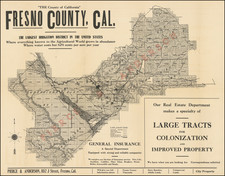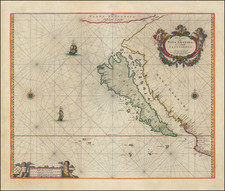Research Work of California's First Great Map Historian
A unique and exceptional object, illustrating the work of George Davidson, one of the great American cartographic minds of the 19th Century, attempting a scientific recreation of three of the most important and earliest recorded Spanish Voyages on the West Coast of North America.
The base chart is a thick paper separately issued chart of Central California, between Morro Bay and Monterey Bay, compiled by the US Coast & Geodetic Survey.
This example of the chart is extensively annotated by George Davidson, and was once part of his collection of maps acquired by the Bancroft Library early in the 20th Century. "[George] Davidson was for many years connected with the United States Coast Survey and is considered the leading authority on the early explorations of the Pacific Coast." (McArthur I, page 371). He served as President of the Geographical Society of the Pacific and published numerous papers on the history of the Pacific Coast. "The list of early navigators who touched on the coast and whose charts and narratives [Davidson] indefatigably searched out is a long one, including Cabrillo (1542), Cermeno (1595), Vizcaino (1602) and numerous other early Spanish and Portuguese explorers . . ." (Lewis, p.108).
Davidson's Reconstruction of The Points Located by Juan Cabrillo, Sebastian Vizcaino and Allesandro Malaspina Using His Own Modern Scientific Methods
In the annotations on this chart, Davidson undertakes a methodical look at the points registered by the three explorers along the Central California coastline. Utilizing the contemporary journals and written accounts of the three expeditions, Davidson meticulously applies his modern observations to record the locations of key points on the various voyages. His work would later become the subject of a published paper on this topic.
As noted by Davidson in the introduction to his 1886 An Examination of Some of the Early Voyages of Discovery and Exploration on the Northwest Coast of America, From 1539 to 1603 (US Coast & Geodetic Survey, Methods and Results . . . . Appendix No 7), page 150,
During my work on the Pacific coast of the United States since the spring of 1850, I became deeply interested in the discoveries and explorations of the early Spanish navigators who had followed the coast from Cape San Lucas to Alaska. Part of my duty consisted in the determination of the latitude and longitude of the headlands, islands, rocks, harbors, rivers, &c., and in the geographical reconnaissance of the shores from the Mexican boundary to the forty-ninth parallel. While in command of the surveying brig R. H. Fauntleroy, I entered (in addition to my regular duties) upon the self-imposed task of writing a Coast Pilot for California, Oregon, and Washington Territory . . . . Very naturally, my early interest in the old explorations became intensified, and I made many special examinations of the narratives and their application to supposed localities. I think I have been able to reconcile many of the discrepancies of the old Spanish, English, American, and French navigators. Their inaccuracies arose principally from "constant" errors of their instruments, ignorance of the coast currents, errors of judgment in estimating distances, &c. Among the Spanish discoverers, the meagerness of detailed descriptions, a failure to seize the salient points for the determining of their positions, the want of minute accuracy in most of their plans—sometimes giving weight to general features and sometimes to details without distinction—and a leaning to exaggerate certain discoveries and to completely overlook others, have much involved the locating of many of their landfalls, headlands, mountains, and streams. . . . I cannot withhold my admiration for the indomitable courage and perseverance of the old Spanish navigators, who, in small, ill-conditioned, and ill-supplied vessels, with crews nearly destroyed by scurvy, fought their way to the wildest parts of the Alaskan coast almost regardless of season. "There were giants in the earth in those days."
The records of such of these voyages as are published are too short to be of much more value than isolated statements of what was done; and the inaccuracy of the observations for the determination of the geographical positions has led many to judge that all were touched with the spirit of Maldonado, de Fonte, and de Fuca. But with the present knowledge of our coast it is possible to locate Ulloa; to track Cabrillo and Ferrelo in their discoveries in mid-winter; to place Drake under Cape Ferrelo and Point Reyes, and to fix with certainty the most of Vizcaino's positions. Later than 1603, I have not undertaken identification in this paper, except to incidentally mention Father Taraval's visit to Point Eugenio, and his landing upon Natividad and Cerros . . . .
Map Details
The chart provides a detailed scientific mapping of the coastline between Morro Bay and Monterey Bay, expanding on earlier regional charts covering the area in lesser details.
Davidson Recreates The Expedition
The map includes two sets of annotations, both almost certainly in the hands of George Davidson, one in pencil, one in pen.
While unsigned, the hand is identical to a chart we offered for sale which was signed by Davidson, with annotations in the same hand.
Rarity
A unique and exceptional object, illustrating the work of one of the great cartographic minds of the 19th Century attempting a scientific recreation of three of the earliest and most important Spanish Voyages on the West Coast of North America.
George Davidson (1825-1911), was one of the most important mapmakers and scientific minds of the 19th Century.
Davidson was born in England and moved to the US in 1832. He met Alexander D. Bache in 1842, when he assisted Bache in his observations of the magnetic elements at Girard College. Upon his graduation in 1845, he began his career as clerk to Bache who was superindentent of the United States Coast Survey.
From 1846 to 1850, Davidson was occupied in geodetic field work and astronomy on the east coast. In 1850, he went to California, where he was engaged in the determination of the latitude and longitude of prominent capes, bays, etc., and of the magnetic elements of the Pacific Coast, including a survey of Washington and Puget sounds, and the main triangulation of the coast in the region of San Francisco.
From 1861 to 1867, he was again on the Atlantic seaboard, principally engaged in engineering work on coast and river defences. In 1866, he became chief engineer of an expedition for the survey of a ship canal across the Isthmus of Darien.
In 1867, he was appointed to make a special examination and report upon the geography and resources of Alaska, pending its purchase; his published report and conferences with congressional committees influenced the passage of the bill. He was placed in charge, during 1867, of the work of the Coast Survey on the Pacific, planned work for the land parties from 1868 until 1875, and inspected all the fields of work.
From 1876 to 1886, he had charge of the main triangulation and astronomical work on the west coast; the records of the computing division showed that the results of his observations stood higher than any ever executed in America, Europe, or India, and they were characterized as “unique in the history of geodesy.
In 1881, Davidson twice measured the Yolo base line, one of the geodesic base lines that formed the foundation of triangulating distances in California. At that time, it was the longest base line yet attempted in trigonometrical operations, and the system of triangulation directly connected therewith was called in his honor the “Davidson quadrilaterals.” He also measured the Los Angeles base line three times in 1888-1889. He retired from the Coast Survey in 1895, after 50 years of service.
Davidson also founded the Davidson Observatory in San Francisco, which was the first astronomical observatory on the Pacific coast of North America, and in 1869 brought the Pacific geodetic of the coast survey in telegraphic longitude connection with Greenwich. His astronomical work includes the observation of the total solar eclipse under the 60th parallel, in 1869; determination of the 120th meridian in 1873; charge of the U. S. transit of Venus expedition, in 1874; recovery of the transit of Venus station of 1709 in Lower California occupied by Auteroche de la Chappe; observation of the total solar eclipse of January 7, 1880; and in 1882 charge of the party to observe the transit of Venus in New Mexico.
Other positions held by Davidson include president of the California Academy of Sciences from 1871 to 1887, Honorary Professor of Geodesy and Astronomy, and Regent of the University of California from 1877 to 1885. After his retirement from the Coast Survey,[4] he became the first professor of geography at the University of California, Berkeley, and chaired that department from 1898 until his retirement in 1905, and remained an emeritus professor until his death. Davidson was one of 182 charter members of the Sierra Club in 1892 and served as a member of its board of directors from 1894 to 1910.











![[ Orange County ] Geological Sketch Map S.E. Portion of Orange Co. California State Mining Bureau . . .](https://storage.googleapis.com/raremaps/img/small/76946.jpg)

![[Southern California] Map of Automobile Roads Banning California](https://storage.googleapis.com/raremaps/img/small/45357.jpg)

![[California] Honor Roll Foresters of America May 1, 1947 to May 1, 1948](https://storage.googleapis.com/raremaps/img/small/63016.jpg)
![[ The Ptolemaic Universe ] Situs Terrae Circulis Coelestibus Circundatae . . .](https://storage.googleapis.com/raremaps/img/small/101512.jpg)